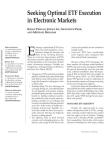As electronic trading markets become more fragmented, the majority of large orders are executed via broker-provided execution algorithms.
Typically, implementation shortfall trading algorithms are used to slice the parent order into many small ones and spread them out over the time horizon to minimize the slippage between average fill price and midquote of order entry, through striking the optimal balance between market impact and volatility risk.
Bloomberg Tradebook’s recent study, entitled “Seeking Optimal ETF Execution in Electronic Markets,” shows that trade costs of ETF orders are quite different from those of common stocks.
 The team has measured trade costs of ETF orders and common stock orders for various order size groups and compared them side by side within each group. The dataset of the study includes more than 100,000 orders trading US common stocks and ETFs from clients of Bloomberg Tradebook throughout the whole of 2013.
The team has measured trade costs of ETF orders and common stock orders for various order size groups and compared them side by side within each group. The dataset of the study includes more than 100,000 orders trading US common stocks and ETFs from clients of Bloomberg Tradebook throughout the whole of 2013.
Results show that the median trade cost of orders becomes higher with increased order size for both common stocks and ETFs. However, given the same order size group, median costs of ETF orders are significantly lower than those of common stocks with 95% confidence.
Also, the study shows that ETFs have tighter cost distribution (i.e., lower variance of trade cost) compared with common stocks. This data implies that ETFs have lower median market impact than common stock of the same order size due to the liquidity of the underlying basket in addition to ETF liquidity displayed in the limit order book of the exchange.
As a result, those trading ETFs directly in exchanges can afford to be more aggressive in taking out liquidity without causing as much market impact as trading common stocks would.
– See more at: http://www.ftseglobalmarkets.com/blog/blomberg-tradebook/etfs-determining-final-trade-costs.html#sthash.Fu93JKAB.dpuf

